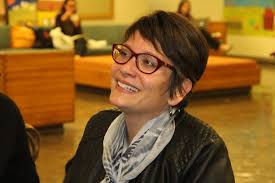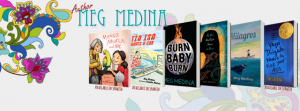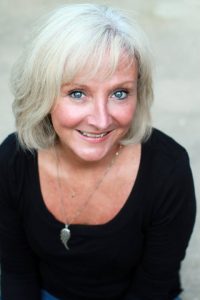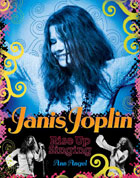 Meg Medina is the author of numerous prize-winning works for children and teens, including Mango, Abuela and Me, Tía Isa Wants a Car, and Yaqui Delgado Wants to Kick Your Ass. Her forthcoming novel, Merci Suárez Changes Gears, will be published by Candlewick Press in Sept 2018. Meg is a founding member of We Need Diverse Books, a faculty member of Hamline University’s MFA program for children’s writing, and serves on the Board of Advisors for SCBWI. More at www.megmedina.com.
Meg Medina is the author of numerous prize-winning works for children and teens, including Mango, Abuela and Me, Tía Isa Wants a Car, and Yaqui Delgado Wants to Kick Your Ass. Her forthcoming novel, Merci Suárez Changes Gears, will be published by Candlewick Press in Sept 2018. Meg is a founding member of We Need Diverse Books, a faculty member of Hamline University’s MFA program for children’s writing, and serves on the Board of Advisors for SCBWI. More at www.megmedina.com.

Ann Angel writes middle grade and YA nonfiction and serves as contributing editor for YA anthologies. Anthologies include Things I’ll Never Say, Stories About Our Secret Selves and Such a Pretty Face, Short Stories About Beauty . Ann’s biography Janis Joplin, Rise Up Singing received the 2011 YALSA Excellence in Nonfiction Award and the 2011 SCBWI Crystal Kite Award, was listed by Booklist as a 2011 Top Ten Biography for Youth and a 2011 Top Ten Arts Book for Youth. Additional nonfiction includes an Amy Tan biography and a reader’s guide to Sandra Cisneros’ The House on Mango Street. Ann teaches creative writing at Mount Mary University in Milwaukee. For more information: www.annangelwriter.com.


Teachers & librarians – Feel free to ask your questions in the comments. It’s fine to ask a general question or to direct one directly to a specific guest author. Our author guests have volunteered to drop in and respond when they can.
Note from Kate: I’ll try to be here for Q and A most Wednesdays, too. Please be patient with me if you’re a first-time commenter – it may take a little while for me to approve your comment so it appears.
Got questions? Fire away!





Wow! So happy to see these authors here today.
Ann, I’m working on a non-fiction at the moment…in fact, I’m about ready to leave my house for some research. I’d love to know about the moments you knew it was time to write…and when it was time to research. Did you ever have to tell yourself to stop one and pick up the other? Or, did it work together for you? Sometimes, I feel like I’m putting off writing with more research and vice versa!
Meg, you know I’m crazy about Merci Suarez! Can’t wait until she’s out on our streets on her bike. Congrats to you and keep going! I would love to know what are your “go to” resources to get a sense of setting. I see that Burn Baby Burn had music….where else do you immerse yourself to get the setting so perfect?
Linda M.
Good morning, Linda! When I start “casting” a book, I imagine the place and who is a native there. So, if it’s in Queens, I’m thinking about a building superintendent and the people at the bus stop and the head of the tenant association and the kids hanging out…all the people we typically find in those settings. And then I make them interact in their world as naturally as possible so that the reader is drawn into the world instead of feeling that the world is being explained to him/her. . Some strategies I use: I hunt around for significant details that linger in the senses and somehow define a place. So, for New York in the 1970s, it’s the clothing, the subway tokens, maybe disco and transistor radios, Sun-In hair lightener, the sound of Dr. Scholls slapping against the bottom of a girl’s foot as she walks, the smell of a street on garbage pick-up day, etc. These are the kinds of things that we remember and that shape a perception. For my upcoming book, Merci Suárez Changes Gears, the setting is south Florida. So I keep in mind the insufferable humidity in September and that sharp St. Augustine grass that hurts your feet , the ibises digging in the sandy dirt after each rain, and of course, those infernal fire ants. Windy days in September? Oh, a hurricane is brewing off shore somewhere… The key for me is not to dwell on the description, but to drop it in naturally through the action and characters.
Hello, Linda. I love research and can easily spend days, weeks, even months researching. Most of my nonfiction deals with biography or historical periods so it’s easy to immerse myself in everything I can find about a character/s and time period. If I’m writing about an author time period, I read fiction and nonfiction that might be set in that era and any biographical or autobiographical material I can find about characters that will be included; obviously, if I’m writing about a musician, I also immerse myself in the music. If I can speak to live subjects, I set up interviews even as I’m doing the written research.
My preference is to write in a narrative nonfiction style so, once I feel I have a handle on the characters, I determine what my narrative tone or voice will be. For Janis Joplin, Rise Up Singing, my tone was definitely that of a fan girl. When I wrote about Robert Cormier, who I think of as the father of YA fiction and who died before I wrote his biography, I interviewed his wife and daughters and wrote from the perspective of what it would be like to grow up with such a father who was writing books your friends were reading. That’s when I write the first chapter and from there, I keep researching even as I write.
Like Meg, I try to drop sensory detail and details of setting into each piece in a way that feels natural to the moment of the characters as they act in their lives.
Thanks for answering questions today! Do either of you have any advice or suggestions for writing a query letter or making a pitch when someone is a new writer?
Hello everyone. Diana, the question of how to write a query letter comes up frequently when I teach emerging writers. It’s important to keep these short and sweet because most of the time these letters are quickly skimmed before an editor reads the first page of your work. It helps to write a one sentence pitch that encapsulates your work. For example, “Art and science interlink in my nonfiction middle grade mystery when a team of forensic anthropologists who recently uncovered the story of a massive burial ground by reconstruct bones discovered in the Milwaukee River.” From there, you might give a few more details in one short paragraph. Then let the editor know you’ve researched the publisher and that this book is a good fit for the publisher because you noticed a number of science mysteries on their list, or perhaps they create a lot of specialty art books. End with a note simply saying you look forward to hearing back. Meg might be able to give you more information about querying for fiction work.
Diana, Let me rework that elevator pitch — it’s not clear as written above (and, obviously, its really important to be clear).
“Art and science interweave in my nonfiction middle grade mystery about a team of forensic anthropologists who recently reconstructed bones from a massive burial ground beneath the Milwaukee River to reveal the story of early settlers.”
You know, I wouldn’t really stress too much about the query letter. I know that sounds strange – and contrary to the ga-billions of articles written about the so-called perfect query. To me, the thing is essentially this: You want to describe your book with the title and a bit of about what kind of book (contemporary middle grade, science fiction YA etc) it is, a bit about the main character and plot that piques someone’s interest, and then with a line or two about what the book is really about in larger terms. (Growing up, coming of age, facing down bullies, etc.) You are writing with the question in mind: How does my book stand out? You also want to be able to say a bit about yourself and your writing and professional credentials. (Yes, it’s okay to say that you’re a debut. How did you find your way to writing for children? What other things have you done?) I think it gets dicey when writers try to oversell the book with pithy comparisons to mega-hits or when they compare themselves to very established authors. So, my advice is: Simple, straight-forward, complete. SCBWI has lots of publications on this. I think I used the sample inside the Writer’s Digest Guide to Children’s Markets.
Good Morning – I appreciate any advice y’all have to share!
I appreciate any advice y’all have to share!
Thanks to both of you for being here! I am currently working on a realistic YA novel. When I say currently, I mean currently for 5 years! With 4 kids of my own and a full time teaching job, I tend to write in spurts. What suggestions do y’all have for carving out time and being more organized? I feel like I spend too much time figuring out where I am in my story instead of moving it forward.
when creating fictional characters, do you most often know the general structure of the storyline before you write or does it arrive as you start fleshing out the character? Meg, those book titles are so compelling, that I have watched students pulling one off the shelf because the character seems to be sitting there calling out for attention.
Hi Barb – Every writer works very differently. For me, the story always begins with the girl (main character) and the immediate problem she has. As I write her story, I always unearth a deeper problem, the one she’s not willing to tell anyone and that is somehow related to the outward problem that we already know. I often compose characters from the people I have known and observed in life. I subject them to a big “Frankenstein” change…sex or species changes…mixing two characters into one…but the sense of character comes from how willing I am to write characters as they really are and not as agents that have appeared to move along my plot. In writing for children, the name of the game is always telling the truth about people.
Hi, thanks for helping out! I’m having trouble creating my 5th grade girl character so she doesn’t have the same characteristics I had in 5th grade. How do I come up with adjectives that would describe her or other ways to describe her? Thanks!
Oooh, beware of adjectives. I like to let characters show me their stripes in their actions and words, in their point of view on things. I find that when I allow the characters to breathe in front of my readers there is almost always a stronger connection. Also, what’s wrong with using yourself as a model for a fifth grader? You’re going to change everything else, yes? So, have at it. And while you’re at it, you can give yourself attributes that you wish you’d had – ha! If it’s truly too awkward, then go on a people watch. Make a conglomerate of the type of girl you generally were or the type of girl that you want to write about. And then, really start digging into her heart…what she’s really like, her secrets and her skills and her lousier qualities, too.
I just need to know if my character is funny or compassionate or how she’d describe herself or how others would describe her in order for me to know how she’d react in certain situations.
Trust me, I don’t want to use myself as the model for her. Anyways, I have to create other characters too, and they can’t all be like me. But I appreciate the people watching idea.
Hi, Barb. I realize this is really a question for Meg but it made me think of the short story anthologies I’ve edited. In each case, I’ve assigned writers a theme and they must write to the theme. Such a Pretty Face was actually an anti-beauty book, one that focused on what happens when teens don’t fit the industrial standards of beauty. Things I’ll Never Say was about the secrets teens keep and the ways secrets can hurt or empower us. In talking to the writers about how they turned theme into story, I learned half worked a story around a specific conflict, finding their characters through unraveling the conflict, and half found a character and wrote the conflict to fit the character’s need or desire to change.
Kelly, You might want to look at The Emotion Thesaurus, a Writer’s Guide to Character Expression by Angela Ackerman. It’s a great handbook for looking up words to show characteristics.
Thank you! I think this will definitely help. I put a hold on it at my library today.
I don’t know this book. Thanks, Ann for adding to the toolbox!
You’re welcome, Meg. It’s a great resource for those days when words just don’t quite hit right.
Thank you for answering questions with us today. I have a couple of questions. I like to know your favorite writing craft books. I have read Bird by Bird by Anne Lamott, and Stephen King’s book. Another question, I know I just need to write to become a “writer,” but did either of you have a writer’s group, or did you submit short stories first? Stephen King says he hates writing groups, but I have heard others say their group helped them so much, and/or writing conferences.
Hi, Kay. Because I teach undergraduate and graduate writing students, I have a huge collection of craft books. For nonfiction, I’m a big fan of Creative Nonfiction: Researching and Crafting Stories of Real Life by Philip Gerard. But craft books by Lee Gutkind are also worth putting on your shelf. For fiction, I’ve been assigning my novel writing students a book called Architecture of the Novel by Jane Vandenburgh. I also just ordered The Thorn Necklace by Francesca Lia Block.
I have belonged to a writers’ group and I’ve studied writing at Vermont College of Fine Arts where I obtained my MFA, but I currently share work with a few readers who are exclusively middle grade and YA writers. It’s a better fit because these readers are writers who are closely connected to writing or publishing for this age group.
Thank you so much for the recommendations!
I don’t care for writing groups because I find that the sometimes conflicting ideas and suggestions is confusing and not always helpful – although the intent is always to be helpful. I did cut my teeth on short stories and on short non ficiton piees for local newspapers and small magazines. So how do I get feedback? I like using one or two trusted readers who respond to specific parts of what I’m writing before I show it to my editor. I choose these readers based on their ability to be honest and insightful..and also because they have an aesthetic that’s similar to what I want to find in my own books. So, for me, less is more. I adore Stephen King’s On Writing, just as you do Kay. I also think Writing Fiction (Burroway et al.) is a really comprehensive look at writing. Not charming and light-hearted, but definitely brimming with good info.
Thank you! I actually have Burrows book, too. When I was getting my masters in English I took two creative writing classes, and this was the book my professor had us buy. Thank you for reminding me about it I haven’t looked at it for a couple of years. Love both of your insights.
Hello Meg and Ann! My question is about classroom libraries. I am a high school ELL teacher and am very encouraged this summer to implement more choice YA novels into my ELL classes. However, I am a traveling teacher meaning I do not have my own classroom. What are some suggestions you have about selecting novels and starting the free reading process in my ELL classes?
Thank you very much!
I think student choice is key in creating a powerful free-reading program in your classroom. Giving students access to books that represent them and that they are free to choose sets the tone, I think, that you trust them and that the experiences that they find interesting to read about have value. Ann has offered some great suggestions. I would add encouraging kids to look at blogs and sites that review books that represent a wide experience. For Latinx students, for example, you might look at Latinx in Kid Lit. But there are so many others that review new voices in the many communities that may be represented in your classroom. (The We Need Diverse Books site has a resources page where you can find many of the links.)
Thank you very much! I will definitely look at blogs and help my students do their own research on books they want to read!
Ooh! I love Meg’s suggestion to follow blogs. (Why didn’t I think of that?) And #weneeddiversebooks is a great website.
Hi, Michelle. This is a great question. I imagine you want a diverse library that’s easy to transport. Do you have any funds available for e-readers? That would be the easiest way to transport many titles. If not, you’ll want to look at paperbacks. You might want to look at older awards–because new award winners will be hardcover–lists such as The Printz Awards, Newbery Awards, YALSA Awards and the Pura Belpre Award. Of course I’d recommend choosing books that reflect your students’ lives and also books that broaden their understanding of the world.
I’m not quite sure if you’re asking for ideas to encourage reading or possible group plans so I’ll try to answer the second part of your question with activities I’ve seen work well for some classes. One idea that works well in my classroom to help students select books is to have students give booktalks in small groups about the books they’ve read and to provide recommendations to one another. A colleague has her students create posters about the books they’ve read to encourage sharing information. I’ve also had students with access to technology create book trailers for the books they’re reading.
Thank you so much for these suggestions! It was a multi-pat question on how to get and transport books and well as how to encourage students to get excited about reading! I will definitely pursue e-readers and model posters and book trailers on books I read this summer to show to my students. Thank you again!
I don’t have a question, but just wanted to tell Meg that I enjoyed your presentation at the Shenandoah University Children’s Literature Conference in June! You were amazing!
Thank you both for taking the time to answer questions and to share all of your expertise with the Teachers Write community!
What a sweet way to end our day together, Jen. Thanks for the wisdom, Ann, and thanks to everyone for trusting us with your questions today.
Thank you, all. This was a great day! Meg, I’ll see you in Wisconsin at the September SCBWI fall conference!